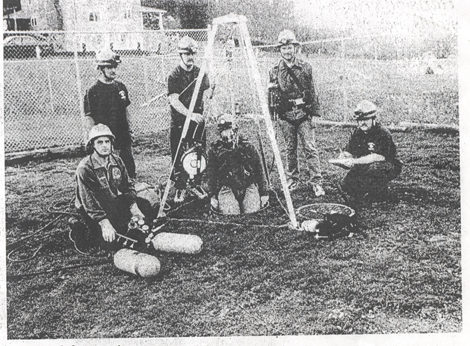
Trained for
action
Mapleton Fire Chief Mike Corbin, left, and other members of the company's
confined space rescue team are prepared with equipment and training
in case of a specific accident. With Corbin are, from the left, Jim
Forshey, Billy Smith, captain Brian Young, Dave Coder and Chris Corbin.
Not pictured are Chuck Rohrer, Lester Secrest and Kevin Glasgow.
(Photo
Kimberly Free)
|
|
Confined
spaces are in every community. They are all around us. They are necessary
for producing our goods, providing community services and storing and
transporting products, according to Mapleton Fire Chief Mike Corbin.
Some examples of these are man holes, vaults, pits, storage tanks, silos,
tunnels, drainage basins and other places of confined access.
As part of their job, some employees must enter and perform work
in confined spaces within several county industries and facilities.
The Mapleton Fire Department addresses incidents that might occur in
such places. Originally established to handle confined space concerns
at U.S. Silica (sand plant) in Mapleton, the volunteers learned that
there was no other such units in the county or surrounding counties.
The company
made a commitment to provide this service to any area if needed. Items
such as rescue ropes, hardware, air monitoring equipment and ventilating
equipment were on hand. Class III harnesses, 4-to-1 rescue pulleys,
helmets, a 25-ft. sock for the ventilation fan, lock-out/tag-out kit
and additional carabiners were newly purchased. Most of the equipment
is multipurpose, and can be utilized in other emergency operatives.
The
team has already been contacted by other counties and industries for
response information should they be in need of the team. Safety and
labor regulations that affect industries also make this local team a
big plus to those facilities that have confined spaces on site
To
supplement its own personnel, the department has an agreement with the
United Volunteer Fire and Rescue Services of Lewistown, PA. This company
has no CSR equipment but does have CSR trained personnel that would
respond and assist when needed.
Department
members state that their newly-formed team is a resource any service
can call upon for help, just like they would the HAZMAT team or tankers
for water supply. |

